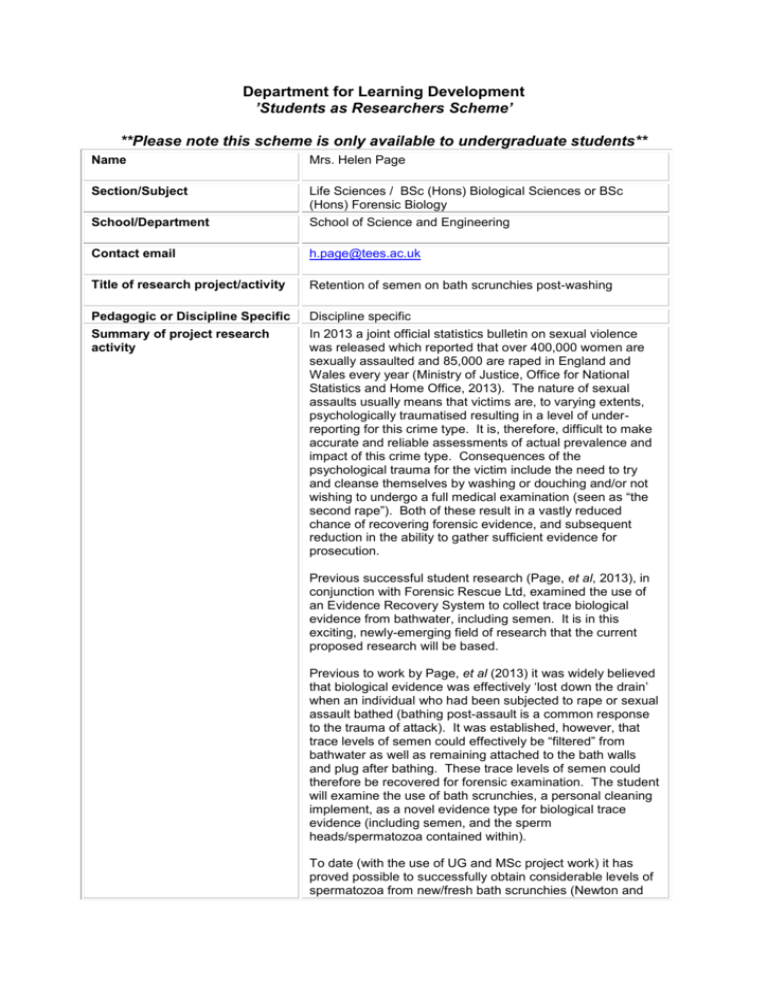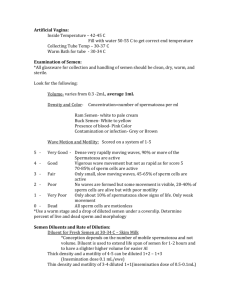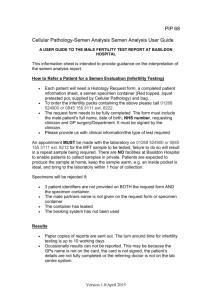Directorate Learning Development
advertisement

Department for Learning Development ’Students as Researchers Scheme’ **Please note this scheme is only available to undergraduate students** Name Mrs. Helen Page Section/Subject Life Sciences / BSc (Hons) Biological Sciences or BSc (Hons) Forensic Biology School/Department School of Science and Engineering Contact email h.page@tees.ac.uk Title of research project/activity Retention of semen on bath scrunchies post-washing Pedagogic or Discipline Specific Discipline specific Summary of project research activity In 2013 a joint official statistics bulletin on sexual violence was released which reported that over 400,000 women are sexually assaulted and 85,000 are raped in England and Wales every year (Ministry of Justice, Office for National Statistics and Home Office, 2013). The nature of sexual assaults usually means that victims are, to varying extents, psychologically traumatised resulting in a level of underreporting for this crime type. It is, therefore, difficult to make accurate and reliable assessments of actual prevalence and impact of this crime type. Consequences of the psychological trauma for the victim include the need to try and cleanse themselves by washing or douching and/or not wishing to undergo a full medical examination (seen as “the second rape”). Both of these result in a vastly reduced chance of recovering forensic evidence, and subsequent reduction in the ability to gather sufficient evidence for prosecution. Previous successful student research (Page, et al, 2013), in conjunction with Forensic Rescue Ltd, examined the use of an Evidence Recovery System to collect trace biological evidence from bathwater, including semen. It is in this exciting, newly-emerging field of research that the current proposed research will be based. Previous to work by Page, et al (2013) it was widely believed that biological evidence was effectively ‘lost down the drain’ when an individual who had been subjected to rape or sexual assault bathed (bathing post-assault is a common response to the trauma of attack). It was established, however, that trace levels of semen could effectively be “filtered” from bathwater as well as remaining attached to the bath walls and plug after bathing. These trace levels of semen could therefore be recovered for forensic examination. The student will examine the use of bath scrunchies, a personal cleaning implement, as a novel evidence type for biological trace evidence (including semen, and the sperm heads/spermatozoa contained within). To date (with the use of UG and MSc project work) it has proved possible to successfully obtain considerable levels of spermatozoa from new/fresh bath scrunchies (Newton and Page, 2013). A strange phenomena has been noted where the recovered sperm heads have clumped together on a substance originating from the bath scrunchies. The student will repeat earlier research but with bath scrunchies that have been used previously in order to: - (a) simulate a more realistic real-life case situation where the used bath scrunchies contain other cell types, bacteria and will have lost some of their tightly packed structure and - (b) to ascertain whether the material responsible for the clumping effect is continually shed from the bath scrunchies. It is hypothesised that, although there may be some impact on the number of spermatozoa which are recoverable, one will still be able to recover sufficient numbers for analysis. Any method of increasing the reporting rates and successful prosecution of these crime types is of benefit within the forensic and policing arena. The field of research is very new, and as such student outputs from the project will become the catalyst for further developments in trace biological evidence recovery and even in the practices and procedures for dealing with victims of sexual assault and rape. References: Page, H., Sarna, A., Watts, L., Ward, E., Hodgson, C. and McKenzie, M., (2013) The recovery of semen from bathwater using the Evidence Recovery System (ERS). Science and Justice, 54 (1), Pp 89-94. Newton, R. and Page, H., (2013) Personal cleaning instruments – a new area of evidence recovery after sexual assault? Poster presentation. FORREST conference. Have you obtained ethical clearance for this project? Ethics approved 24th September 2014 Summary of student tasks The student will be building upon previous laboratory research carried out at TU. The student will be expected to: - Complete (with guidance) COSHH and risk assessments for the laboratory work - Prepare the bath scrunchies with semen, following established protocols - Examine and test the bath scrunchies using Acid Phosphatase to determine the presence/absence of the presumptive enzymatic marker for semen - Extract semen and prepare microscope slides using Haematoxylin and Eosin staining for the detection of spermatozoa - Examine the prepared slides using high-powered microscopy (400X) and meticulously note the number of spermatozoa found, using established methods - Complete data analysis (of the results of this study and previous UG and MSc research data) - Assist in preparation and drafting of a journal article for publication (results dependant) Research output(s) for student It is envisaged that the student be at least Level 5 of study within the programme areas of BSc (Hons) Biological Science/Forensic Biology/Forensic Science. S/he will, therefore, be familiar with the proposed methodology and have experience with working within the science laboratories. Specifically, the student will have an enhanced learning experience with this additional opportunity. It will provide them with experience in the field of research in preparation for career development within this area (further study/PhD research). It also permits them a unique opportunity to be involved in a newly-emerging field of forensic research. The student will have the opportunity to: - Draft COSHH and risk assessment documentation, thereby increasing their understanding of legal requirements in association with Health and Safety - Gain an understanding of biological evidence analysis - Develop their laboratory (specifically slide preparation, slide analysis and microscopy skills) and data analysis skills - Further develop good laboratory practices introduced to them in their degree programmes - Enhance their CV with co-authorship of a paper Are there specific criteria students need to address when applying for the project? Students must: - Be willing to work with human biological samples (semen) - Adhere to strict legal requirements on the use of human tissue, according to the Human Tissue Act 2004 and in-line with SSE ethical and Health and Safety guidelines - Have an understanding of health and safety practices - Have relevant laboratory experience e.g. slide preparation, microscopy - Possess an interest in the research area It is desirable that students have: - Understanding of good laboratory practices Anticipated timeline for project The timeline is flexible/negotiable around the students’ teaching timetable, assessments and other commitments. November/December - COSHH and risk assessment completion (2 hours) - Laboratory training (if required) and competency assessment (2 hours) December/January/February/March - Approximately 3 hours/week of laboratory work (48 hours) April/May - Data analysis (10 hours) Throughout - Supervisory meetings (3 hours) Number of student hours required (up to 65) 65 hours Are there any additional costs associated with the student researcher i.e. travel? Please provide details of how this will be funded The student will be working on site at Middlesbrough TU campus.






